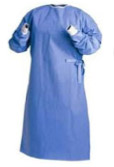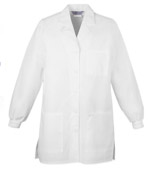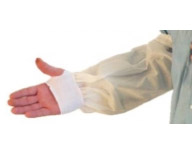To minimize exposure to hazardous materials or other workplace hazards, proper clothing should provide reasonably complete coverage of the skin and clothing. For lab workers, best practices include wearing a knee-length, long-sleeved, elastic-cuffed laboratory coat while working with hazardous materials. A lab coat provides a protective layer and can be easily removed if contaminated or in the event of a lab accident.
For non-lab employees at UVM, skin protection is required for certain job tasks and may include long pants and long sleeves in specific materials, such as 100% cotton, to protect against physical hazards.
Lab Coat Choices
A risk assessment should be conducted before an appropriate lab coat is chosen. Once the hazards have been identified, review information about typical lab coat materials and determine the best options for your lab. One type of lab coat may not work for all lab operations. If help is needed in completing a PPE assessment, contact Safety staff. Here are a few general reminders and tips for lab coat usage:
- The use of lab coats is required for work in all BSL-2 labs.
- Lab coats with elastic cuffs are recommended to avoid contamination.
- Snaps, vs buttons, are recommended for easy removal.
- Never roll up or push up lab coat sleeves; it is important to cover the arms to the wrist.
- If a lab coat becomes grossly contaminated, it should be handled as waste.
 Disposable Lab Coats
Disposable Lab Coats
Disposable lab coats are the best option when working with animals and/or biological hazards. Properly dispose of them immediately when contaminated or at the end of the day. A closed-front lab coat is required when using disposable coats for biological work. Some disposable lab coats are made of a thin plastic layer which prevents the wearer from being exposed to liquids like blood. Disposable lab coats must be thrown away after use, saving the wearer from having to wash them. Dispose of as hazardous waste, biological waste, or radioactive waste based on the contaminants on the coat.
Autoclavable lab coats are also available from some manufacturers. These lab coats can be autoclaved several times before they need to be discarded. Remember, never autoclave a lab coat that is contaminated with chemical or radioactive material.
 Reuseable Lab Coats
Reuseable Lab Coats
Flame-resistant lab coat
The term flame-resistant refers to the characteristic of a fabric that causes it NOT to burn in air. Flame-resistant lab coats are highly recommended when working with pyrophorics, open flames, large volumes of flammable materials, or highly reactive materials and processes. These lab coats are either treated to not burn or the material is inherently flame-resistant.
Nomex offers the highest level of lab coat protection from fire. Nomex is strong, flexible, resistant to tearing, and protective against most solvents, acids, and alkalis. The disadvantage of a Nomex lab coat is that it will lose strength over time if exposed to chlorine bleach.
Fire-resistant cotton lab coat
These are cotton lab coats that are treated with a fire-resistant material. The treatment may dissipate after repeated laundering or extended use. The use of bleach is not recommended for fire-resistant garments, making them a poor choice for work with biological hazards.
100% Cotton lab coat
100% cotton lab coats are appropriate for general lab operations that do not require another specific type of lab coat. They can be superior to synthetic blends for fire-resistance but inferior to the coats mentioned above. They rarely last more than one year with daily use and can be degraded by acids. 100% cotton lab coats should be laundered routinely by a professional laundering service.
Synthetic/cotton blends
100% polyester coats and cotton/polyester blends are the most combustible and are not considered appropriate for working with flammables. Blended lab coats should be laundered routinely by a professional laundering service.
Laundering Choices
NEVER take lab coats home or to the laundromat.
- Lab groups can contract with a local uniform or laundering service that has the capability of laundering laboratory coats. One vendor option for departmental laundering services is Foley Services. Contact Safety staff if you need more information.
- If laundering of lab coats is not possible/reasonable, disposable lab coats should be used instead.
- Lab coats treated with fire-resistant material require special cleanings that a professional service should be able to provide, but check with the service first.
- If a lab coat becomes grossly contaminated, it should be collected and disposed of as hazardous waste. This includes any lab coat that is contaminated with a biological, chemical, or radioactive material.
- If there is access to a departmental washer/dryer, contact Safety staff to evaluate both the safety and effectiveness of this cleaning method.
 Aprons
Aprons
An apron is not a substitute for a lab coat; an apron should always be worn over a lab coat. Before ordering or wearing an apron, carefully determine the type of material and style that you need. Check with the manufacturer for chemical resistance information on a particular apron. As with gloves, there is an option of silver shield material in an apron that is resistant to most chemicals, but it can be very expensive.
A risk assessment should be completed to determine the best type of apron for the work being performed. An apron should be considered for certain hazards:
- Heavy acid use
- High risk of chemical splash
- Thermal hazards, including:
- Ovens
- Autoclaves
- Glass/cage washers
- Certain biological work with splash risk
Barrier Gowns
Barrier gowns (e.g. yellow in UVM's Animal Care Facility) are for use in animal care facilities to protect the animals. These gowns do not protect the user from hazardous materials (e.g. chemical, biological, or radiological agents). The blue barrier gowns used in UVM's Animal Care Facility are for BSL-2 work, and offer some increased protection. Barrier gowns come in several different materials as well: polypropylene, SMS, poly-coated, and reusable materials. Barrier gowns are not a substitute for disposable lab coats, since many barrier gowns are not as resistant to liquids. A risk assessment can determine the best type of barrier gown for your work.
The opening of the gown should be in the back (side or back tie), and the gown should be secure at the neck and waist.
 Sleeves
Sleeves
In some cases, sleeves can provide additional protection. Protective sleeves are not a substitute but are to be used in addition to lab coats. Use sleeves when there is a high risk of contact or splash with hazardous materials. Most sleeves are disposable and should be handled appropriately after one use. As a reminder, gloves should be placed over the cuff of the sleeve.
